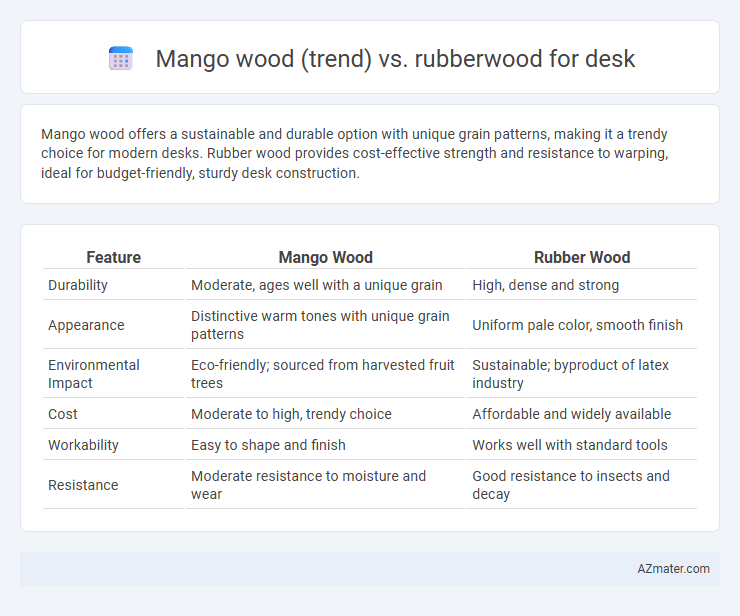Mango wood offers a sustainable and durable option with unique grain patterns, making it a trendy choice for modern desks. Rubber wood provides cost-effective strength and resistance to warping, ideal for budget-friendly, sturdy desk construction.
Table of Comparison
| Feature | Mango Wood | Rubber Wood |
|---|---|---|
| Durability | Moderate, ages well with a unique grain | High, dense and strong |
| Appearance | Distinctive warm tones with unique grain patterns | Uniform pale color, smooth finish |
| Environmental Impact | Eco-friendly; sourced from harvested fruit trees | Sustainable; byproduct of latex industry |
| Cost | Moderate to high, trendy choice | Affordable and widely available |
| Workability | Easy to shape and finish | Works well with standard tools |
| Resistance | Moderate resistance to moisture and wear | Good resistance to insects and decay |
Introduction to Mango Wood and Rubber Wood
Mango wood is a sustainable hardwood popular for desk manufacturing due to its durability, attractive grain patterns, and eco-friendly sourcing from harvested mango trees after fruit production declines. Rubber wood, derived from mature rubber trees after latex extraction, offers a cost-effective, sturdy material favored for its light color and smooth finish ideal for office furniture. Both woods provide unique aesthetics and environmental benefits, making them top choices in contemporary desk design trends.
Current Trends in Mango Wood Furniture
Mango wood furniture is currently trending due to its sustainable sourcing and rich, warm grain patterns that enhance modern and rustic desk designs. Compared to rubber wood, mango wood offers greater hardness and durability, making it ideal for long-lasting desks. Its eco-friendly appeal and unique, naturally distressed texture drive consumer preference in contemporary furniture markets.
Sustainability: Mango Wood vs Rubber Wood
Mango wood is highly sustainable due to its fast growth and use of old fruit-bearing trees that are no longer productive, reducing deforestation. Rubber wood also ranks well in sustainability because it is harvested from rubber trees after their latex-producing lifecycle ends, promoting resource reuse. Both woods offer eco-friendly options, but mango wood's quicker growth cycle often leads to a smaller environmental footprint compared to rubber wood.
Durability and Strength Comparison
Mango wood offers a unique blend of durability and moderate strength, making it ideal for stylish desks that require a balance between aesthetic appeal and functionality. Rubber wood, known for its robust density and hardness, provides superior strength and long-lasting durability, often outperforming mango wood in heavy-use scenarios. Choosing between the two depends on the need for resilience against wear and tear, with rubber wood being favored for more intensive daily use and mango wood prized for its distinctive grain and sustainability.
Aesthetic Appeal: Grain, Color, and Texture
Mango wood offers a rich, warm aesthetic with diverse grain patterns featuring swirls and knots that create a unique, rustic charm ideal for statement desks. Its natural golden hues evolve to a deep amber patina over time, enhancing visual interest and warmth in workspace design. Rubber wood, by contrast, presents a more uniform, straight grain with a pale cream to light brown color, lending a smooth and contemporary look that suits minimalist and modern desk styles.
Price Differences and Market Value
Mango wood desks typically offer a higher market value due to their distinct grain patterns and durability compared to rubber wood, which is more affordable and widely available. The price difference often reflects mango wood's status as a premium material favored for unique, artisanal furniture pieces, while rubber wood is valued for cost-effective, mass-produced desks. Buyers seeking long-term investment and aesthetic appeal tend to prefer mango wood despite its higher cost, whereas budget-conscious consumers lean towards rubber wood for its economic advantage.
Workability for Desk Manufacturing
Mango wood offers excellent workability for desk manufacturing due to its fine grain and smooth texture, making it easy to cut, shape, and finish. Rubber wood, also widely used, provides good workability with steady grain and resistance to warping, but it is slightly harder and can be more challenging to machine compared to mango wood. Both woods are sustainable choices, though mango wood is often preferred for intricate designs and detailed craftsmanship in desks.
Environmental Impact and Ethical Sourcing
Mango wood is increasingly popular for desks due to its sustainability, as it utilizes trees that no longer produce fruit, reducing waste and promoting ethical sourcing in agroforestry systems. Rubber wood, harvested from mature rubber trees after latex production ends, supports a circular economy but may involve concerns over pesticide use and deforestation in some regions. Choosing mango wood often results in lower environmental impact and better social outcomes compared to rubber wood, aligning with eco-friendly furniture trends.
Maintenance and Longevity
Mango wood offers moderate durability with natural resistance to moisture, requiring regular oiling to prevent drying and cracking, making maintenance essential for longevity. Rubber wood is highly durable and resistant to pests, needing minimal upkeep aside from occasional cleaning and polishing to maintain its smooth finish. Both woods provide sturdy desk options, but rubber wood typically ensures longer-lasting performance with less intensive maintenance.
Choosing the Best Wood for Your Desk
Mango wood offers a unique blend of durability and rich grain patterns, making it a trendy choice for stylish, eco-friendly desks that stand out. Rubber wood, valued for its hardness and affordability, provides a sturdy and sustainable option often favored in functional office furniture. Selecting the best wood for your desk depends on balancing aesthetics with durability, where mango wood excels in visual appeal while rubber wood ensures long-lasting strength.

Infographic: Mango wood (trend) vs Rubber wood for Desk
 azmater.com
azmater.com